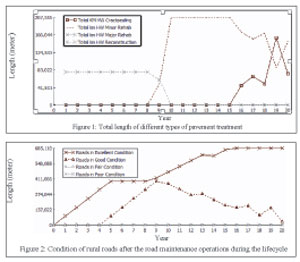
Improving rural roads helps poverty reduction
Md Shohel Reza Amin | Tuesday, 31 December 2013

Since the inception of Bangladesh Rural Transport Improvement Project in 2003, more than 2,500 kilometres of rural roads were maintained and improved in the country. Despite big investments to develop the country's rural road network, the condition of it has remained far from satisfactory. The World Bank (2012) reported that only 37 per cent of rural people were living within the proximity of two kilometres of an all-season road and that 35.61 per cent of roads at the upazila level were of the all-weather standard in 2000.
The absence of a periodic road management system may have significant social and economic impacts on rural communities and local governments. The National Strategy for Accelerated Poverty Reduction (2004) observed that the improvement of rural roads rather than expanding the network made a significant contribution to poverty reduction as stated by the Local Government and Engineering Department (LGED) in 2010.
The Roads and Highways Department (RHD) has gradually improved the quality of maintenance work by following the World Bank Highway Design Manual (HDM) method over the last twenty years. However, the annual maintenance work on rural road infrastructure is still done depending on the road condition. Road maintenance funds are allocated to each district based on the road condition and structural inventory of each district. The LGED proposed uniform weight-based criteria for allocating maintenance funds for the districts. However, the predefined weight of criteria may not be the same for all districts.
The LGED conducts the periodic maintenance work on bituminous roads in three ways: resealing, overlaying, and rehabilitation. Resealing, carried out once in every 3 to 5 years, includes the addition of a thin film of surfacing to improve the surface integrity and waterproofing, or to improve skid resistance. Overlaying, carried out at an interval of 8-10 years, includes the addition of a thick layer to improve the structural integrity and increase the strength of the pavement. Rehabilitation requires reinstating the pavement to the same condition it had at the time of construction or subsequent reconstruction.
The LGED has developed a Road and Structure Database Management System (RSDMS) to store the road condition data. The LGED is planning to include the location of union council complexes, growth centres, rural markets and other social infrastructure (schools, colleges, madrasas, community clinics, health centres, cyclone shelters etc.) in the RSDMS.
This scribe has developed a framework to optimise the maintenance work on rural roads based on the pavement condition and social benefits for the nearby villages. The rural road network in Gazipur district is considered the test case for applying the structured pavement management system (PMS) on a larger scale. Initially, the pavement performance curves were prepared for the rural road network based on the mechanistic model of roughness progression of the pavement surface.
The HDM III of the World Bank has also adopted this mechanistic model of pavement performance. The social benefits for villages from maintenance of a road network were estimated by applying functional hierarchy and centrality of the villages. The greater the importance of the function (e.g. educational institutions, grocery, health centres, agricultural industries, markets, growth centres etc.) in terms of centrality is, the higher the weight is. The centrality weight was defined as the Rural Priority Indicator (RPI) of each village. The RPI of each road link was calculated by summing up the RPI of each village within the 5-km buffer zone of each road link.
Finally, the lifecycle optimised was structured to achieve and keep the pavement condition index (PCI) at the highest level and ensure social benefits for the villages at minimum costs.
It is very difficult to ascertain the annual rural road maintenance budget of the LGED for each district. During the financial year 2010-2011, the LGED allocated a total of USD 17.56 million in an annual budget for construction and maintenance of rural roads. Hence, the anticipated annual rural road maintenance fund from the LGED for each district can be US $ 274,342. The pavement condition of the rural road network in Gazipur district would likely improve by only 9.4 per cent, as far as this anticipated budget is concerned. With this annual budget, 83.2 per cent of the rural roads in Gazipur district will attain the threshold condition. Maximisation of the service (condition) level of the total network under this budget was then used to find the optimal strategic results for PMS. The lifecycle optimisation model estimation has showed that a total of 625 km of bituminous roads will require reconstruction during the first 8 years (Figure 1).
After that, a total of 398 km, 203 km and 60 km of rural bituminous roads in Gazipur district will require resealing, overlaying and reconstruction in order to maintain the pavement condition (Figure 1). The road condition will improve because of the periodic pavement maintenance work. For example, the pavement condition of the 685 km of rural bituminous roads will be excellent during the design period of roads (Figure 2). On the other hand, the proportion of rural bituminous roads, in good condition, will increase in nine years (391km of pavement) and then decrease after that (Figure 2).
This study provides a guideline on rural road maintenance work. This model will enable the authorities to do the maintenance work systematically and in a well-planned way within the limits of the budget.
The writer is Research Assistant for a project funded by the Natural Sciences and Engineering Research Council of Canada and also Research Assistant of the New Rural Economy Project of the Canadian Rural Revitalisation Foundation. He is doing his PhD on Civil Engineering at Concordia University. md_amin@encs.concordia.ca